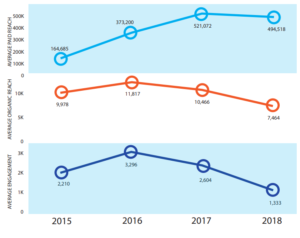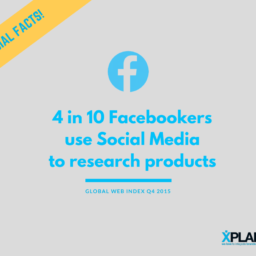BUILDING FUTURE-PROOF BRANDS IN AN ALGORITHMS-DRIVEN WORLD
Given Social Media’s power and Facebook’s recent far-reaching changes, it’s a good time for Marketers to revisit the fundamentals of their Brand Communications’ Strategies.
Retaining control of the agenda in an era of constant digital transformation is challenging. However, it is the only way to future-proof your marketing efforts and drive results.
Facts
Across most popular Social Networks, visibility of a Brand’s posts in users’ feeds is dictated by ever-shifting algorithms that act like moving targets.
Facebook, still the predominant global platform, is constantly tweaking its News Feed algorithm, and Organic Reach has been declining for years. Engagement has been dropping as well, despite a continuous investment in Promotion.
Evolution of Paid Reach, Organic Reach, Interactions Per Post

In January, Facebook announced that it is changing its algorithm again to improve user experience and offer meaningful and authentic interactions between people. However, this new change will further restrain the visibility of unpaid brand posts.
Implications
Marketers no longer have unpaid access to Facebook’s 2.2 billion monthly active users.
Higher Engagement doesn’t positively impact the organic distribution and amplification of a Brand’s content as before.
Organic Reach of pages will likely decrease further, but this is also dependent on types of content and levels of engagement.
Facebook’s latest News Feed overhaul could have an impact on paid performance as well. As more advertisers come aboard, competition increases in the ad-auction, which generally results in higher ad prices.
Recommendations
Establish a Content-First approach.
Rework content strategies to ensure you are consistently producing and posting meaningful, conversation-provoking content to mitigate the negative impact on Organic Reach and retain a good Facebook Ads’ Relevance Score, that continuously optimizes your paid investment.
In his announcement, Zuckerberg wrote that “Pages making posts that people generally don’t react to or comment on could see the biggest decreases in distribution. Pages whose posts prompt conversations between friends will see less of an effect.”
Add more interactive or snackable gamified content into the mix or use timely content that users will more likely have an opinion on. Live videos, based on Facebook data, get on average six times as many interactions as regular videos. Evergreen content that can be useful for your audience for longer periods of time, gives you the opportunity to repurpose it again and again, and can have an extremely long lifespan. User-generated content triggered by regular activations drives multiple-times higher engagement than plain branded content.
Start being strategic and consistent with the content you publish and promote.
Steer clear of “Engagement Bait”.
Avoid seeking to manipulate the News Feed algorithm by enticing Engagement to achieve higher Reach. Machine Learning and models that Facebook has developed to protect users from this type of content means that “engagement bait” will appear less in the News Feed.
Encourage users to follow your Facebook page.
According to Facebook, people following Pages will still see those Pages’ posts at the top of their News Feed. Going one step further, you can also create invitation-only Groups for your most engaged audience, leveraging Facebook groups to listen, nurture and further connect with your Brand’s advocates.
Capture the Attention of your Audience.
With consumers’ attention spans constantly dropping and billions of daily published pieces of content competing for their attention on the feeds, your visual content should be able to cut through the noise. So, don’t leave it be an afterthought. Algorithms can now predict which areas/objects are most likely to attract consumers’ attention – before the viewers are even aware that they’re looking at something. As a result, only Brands that can be armed with data-driven predictive knowledge on their content’s performance and consumers’ attention probability, are best equipped of driving visual assets’ optimization and best utilization in advance.
There is a world beyond Facebook.
Create a healthy distribution mix, building across multiple channels to secure your Brand’s Visibility. Contrary to Facebook where the primary appeal is connecting with family and friends, Google and other search-friendly platforms as YouTube are the main outlets people will turn to, when in need to search for the areas they are interested in. As a result, seeding search-engine optimized content beyond Facebook can connect the Brand with its values and make it visible when people are searching for the things they care about, as people will rarely search directly about a Brand. With currently over 2.5B active users globally, you may also want to explore your Brand’s participation in Messaging Platforms.
Influencer Marketing 2.0.
As the large majority of influencers own Brand pages, they will also likely experience the negative impact of Facebook’s recent algorithm change. Make it a habit to also think beyond mega influencers. Think basics, leveraging influence networks such as your employees to further build advocacy.
Most importantly:
Focus on Owned Media:
Your website. Your email list. You own nothing in Social Media. Building purely on social networks is like only investing on rented land. As marketers you need to be concentrating efforts on always driving users recruited across social or search, back to the experiences you own, or access to them could be wiped out during the next algorithm change.
Keep Testing, Measuring & Going Back to the Drawing Board.
As the role of earned media, influencers, friends, and networks continues to grow, driven by Algorithms seeking to secure users’ experience when the latter are out and about on the various networks, continue monitoring your data and analytics on a regular basis, focusing on the KPIs and metrics that matter the most, to optimize and adjust strategies accordingly.
The reality is that, as marketers, we don’t always need to go big, market to everyone. We just need to reach our potential consumers, when and where they are ready to buy. The prerequisite to achieving razor-sharp targeting to mass relevant and qualified audiences is that we must have access to the most powerful insights into our data. That is where Artificial Intelligence and Machine learning will keep disrupting the industry. The winners will be those in the position to best exploit their data and extract useful insights faster than their rivals to provide consumers with exactly what they need, when before they know they need it 🙂











